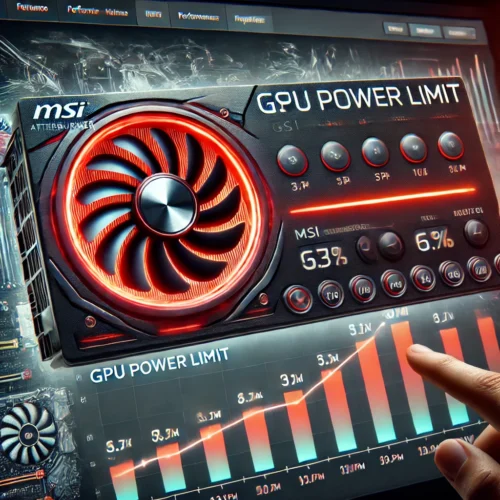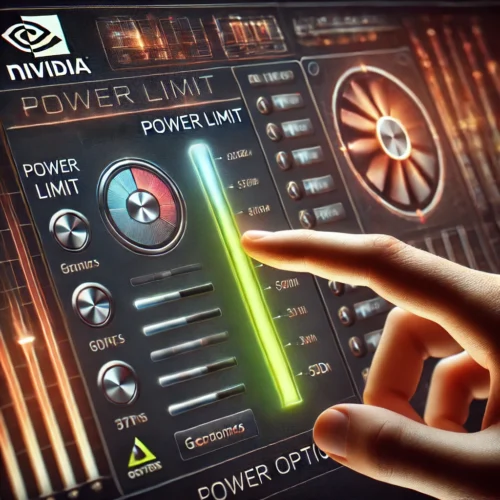The GPU Power Limit plays a key role in your computer’s performance, particularly in tasks like gaming, video editing, or rendering. Knowing how to check and adjust your GPU power limit can help you maximize your system’s potential. In this guide, we’ll walk you through the process, including the best tools to use and essential tips for boosting performance safely.

Why is GPU Power Limit Important?
The GPU Power Limit dictates how much power your graphics card is allowed to consume. By monitoring and adjusting it, you can either enhance performance or conserve energy, depending on your needs.
- Higher power limit: Enables more power consumption for better performance, but may increase heat and reduce efficiency.
- Lower power limit: Constrains power usage, which can reduce performance but improve system stability and longevity.
Benefits of Adjusting GPU Power Limit:
- Better Performance: Especially helpful for gaming and graphics-heavy tasks.
- Increased Longevity: Reducing power limits can extend your GPU’s lifespan.
- Energy Efficiency: Optimizing power can save energy costs over time.
How to Check Your GPU Power Limit
There are several ways to check and monitor your GPU Power Limit, using third-party software and built-in tools. Below are some of the most reliable tools available.
1. MSI Afterburner
One of the most popular tools for GPU management is MSI Afterburner. It provides detailed statistics on power consumption, temperature, and allows users to modify their GPU’s power limit.
Steps to Check GPU Power Limit with MSI Afterburner:
- Download and Install MSI Afterburner from the official website.
- Open the application and locate the Power Limit slider on the main dashboard.
- Adjust the slider to increase or decrease your GPU’s power limit.
- Monitor the real-time changes through the app’s performance graphs.
Tip: Make sure to adjust power limits slowly to avoid system crashes or overheating.

2. NVIDIA Control Panel
If you have an NVIDIA GPU, you can use the NVIDIA Control Panel to monitor and adjust your GPU Power Limit.
Steps to Check GPU Power Limit with NVIDIA Control Panel:
- Right-click on the desktop and open NVIDIA Control Panel.
- Go to Manage 3D Settings.
- Look for Power Management Mode and change it from Optimal Power to Maximum Performance to give the GPU more power flexibility.
This setting won’t give you direct control over the exact wattage, but it allows the GPU to use more power when necessary.
3. AMD Radeon Software
For AMD users, the AMD Radeon Software also offers options to monitor and control power usage.
Steps to Check GPU Power Limit with AMD Radeon Software:
- Open Radeon Software and go to the Performance tab.
- Click on Tuning and scroll to find the Power Limit slider.
- Adjust the slider to increase or decrease power usage as needed.
Tips for Adjusting Your GPU Power Limit
Monitor Temperature Regularly
Adjusting your GPU Power Limit can lead to higher temperatures, especially when increasing power for better performance. You should regularly monitor your GPU temperature to prevent overheating.
Pro Tip: Check out our guide on How to Monitor GPU Temperature with Software Solutions to stay on top of heat management.
While pushing your GPU to its maximum power can boost performance, it’s not always necessary. Keeping the power limit slightly below the maximum can provide a good balance between performance and longevity.

Tools to Monitor GPU Power Usage
Along with MSI Afterburner, NVIDIA Control Panel, and AMD Radeon Software, here are a few more handy tools:
- HWMonitor: A lightweight tool to monitor power consumption and temperature.
- GPU-Z: Provides a detailed breakdown of GPU specs, including power draw.
- HWiNFO: A comprehensive tool for monitoring both CPU and GPU power usage.
These tools will ensure you keep an eye on power usage and make necessary adjustments when needed.
Final Thoughts
Understanding and checking your GPU Power Limit is essential for optimizing performance, especially in gaming and professional tasks. By using the tools and tips shared here, you can easily adjust power limits, monitor temperature, and find the perfect balance between power and performance.
Remember, it’s crucial to keep track of your system’s GPU temperature to avoid overheating while maximizing your GPU’s power potential. Take control of your graphics card, and enjoy enhanced performance today!
FAQs
Q: What is the power limit of a GPU?
The power limit of a GPU is the maximum amount of power (measured in watts) that a graphics card can draw. It controls how much energy the GPU can use during intense workloads. A higher power limit allows the GPU to consume more power, potentially increasing performance, while a lower limit restricts power usage, promoting efficiency and cooling.
Q: How do I know how much power my GPU needs?
To determine how much power your GPU needs, you can:
- Check the manufacturer’s specifications on the GPU box or website, which typically list the recommended power supply unit (PSU) wattage.
- Use third-party software like HWMonitor or GPU-Z to monitor real-time power consumption during usage.
- Calculate it based on the system’s power draw under load, considering other components like CPU and peripherals.
Q: How to check GPU capacity?
To check the capacity of your GPU (also referred to as VRAM or memory size):
- On Windows, open the Task Manager (Ctrl + Shift + Esc), go to the Performance tab, and select GPU. Here, you can see memory usage and capacity.
- You can also use third-party tools like GPU-Z or MSI Afterburner to get detailed information about GPU capacity and other specs.
- For detailed specs, visit the GPU manufacturer’s website and check the memory size.
Q: How do I check my GPU TDP?
You can check your GPU TDP (Thermal Design Power) using the following methods:
- Manufacturer’s specifications: The TDP is usually listed on the product page or manual provided by the GPU maker.
- GPU Monitoring Software: Tools like HWMonitor, HWiNFO, or MSI Afterburner can display the current TDP and other power metrics.
- GPU-Z: This tool provides a detailed breakdown of your GPU’s power consumption, including the TDP.
